Yoga for a Healthy Lower Back (23 page)
Read Yoga for a Healthy Lower Back Online
Authors: Liz Owen

Visualize friendliness, compassion, happiness, and equanimity growing in your heart. Rest with your attention in your heart for a few moments, until your mind and heart become united in these qualities. With your next exhalation, visualize serenity flowing from your heart deep down into your sacrum. Hold your awareness in your sacrum now, and feel that with each breath peacefulness moves throughout your sacrum, cleansing and rinsing away tightness, holding, darkness, and dullnessâall the toxic things that can settle into the sacrum and cover its light.
Now visualize that sacral light, the subtle, coiled Kundalini energy, awakening and flowing through your sacrum and through the energy channels of your spine, bringing life and energy into every part of your being.
Grow and Progress
Once you are comfortable with all the poses in the practice section, you are ready to move on to practice poses that require more stability and strength in your sacrum. I've included a few poses that ask for more stretch across the sacral band and a few that build strength in your lower backâexcellent next steps for moving forward in your sacral healing journey. I've also included seated twists, which some students with sacral issues love and which completely vex others. The twists are sequenced starting with less stretch and moving into deeper stretch. Start to practice them slowly and explore how they feel in your body. In particular, proceed into Proud Warrior Pose and Wide-Legged Standing Forward Bend only when you feel confident that your sacral joints are ready to do so. You'll know when you're ready because you'll be able to describe your sacrum with the quote from the Yoga Sutras of Patanjali that I mentioned in chapter 2:
sthira-sukham asanam,
which means that a posture should be “steady and comfortable.”
12
Chair-Seated Twist
Stretch | Bharadvajasana Variation
For this pose, you'll need a folding chair, or any chair in which you can sit with your knees level with your thighs and your feet flat on the floor. Sit with the right side of your body parallel to the back of the chair. Place your feet directly below your knees, and place a block between your knees. Your feet
should be even with each other and so should your knees. Place your hands on your hips and feel that they are balanced over your legs. Squeeze your knees into the block to hold it in place; this stabilizes your hips and sacral joints.
With an inhalation, lift your arms straight up. As you exhale, turn your torso to your right and place your hands on the back of the chair. Press down on the chair with your hands to help lift your torso upward as you inhale, and gently push your left hand into the chair to turn more deeply to the right as you exhale. Be mindful that you are rotating your torso and not your hips. Keep your torso as upright as possible, and keep the centerline of your head aligned with the center of your sternum. Once you've moved into a comfortable twist, with your lower back in a sustainable stretch, turn your head to the right and glance over your shoulder to give your neck a gentle stretch (
fig. 3.24
). Caution, however, is advised for those with neck issues.
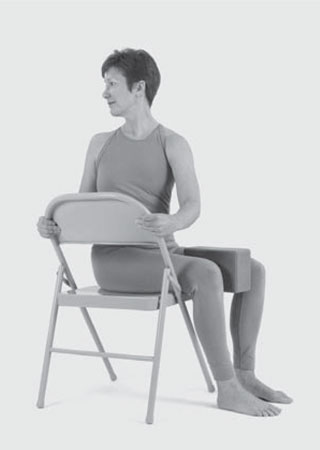
FIG. 3.24
I've started this section with Chair-Seated Twist because it is an excellent way to rotate your spine and elongate your lower back while keeping your sacral joints and hips aligned and stabilized, which makes it safer for imbalanced sacral joints than poses in which your hips are freer to move around. Twists can feel particularly soothing for a sacral sprain or if your lower back feels compressed. If your sacral joints feel overstretched, experiment with placing a belt around the widest part of your hips to create stability in the joints.
Seated Crossed-Legged Pose Flow
Stretch | Gomukasana Variations
You practiced Reclining Crossed-Legs Pose in chapter 2, giving the piriformis and gluteus maximus muscles a good stretch while your sacral joints and lower back were supported on the floor. Now that you are ready to go a little deeper into your hips and sacrum, you'll practice a seated version of this pose with a twist, side bend, and forward bend added in. Seated Crossed-Legs Pose may feel like a strong stretch in your hips and across your sacral band. I have two suggestions that might help you do it safely and fullyâthe first is to
sit up on as much height as you need so you feel a comfortable, sustainable stretch, and the second is to take a break between each of the four steps listed below. Come out of the pose, stretch your legs, even walk around the room once or twice, then come back into the sequence until you have finished all four steps.
Step 1: Cross Your Legs
Sit with your legs extended straight forward. Bend your knees and fold your left shin under your right leg. Then cross your right leg over your left leg. Bring your knees as close to one another as you can. Be sure your hips are in an upright, neutral position. Sit on a bolster or a folded blanket if this is difficult or if there is discomfort in your hips or your knees (
fig. 3.25
). Stay here for a few breaths and let your hips release. Visualize your hip bones spreading and wrapping around your outer hips, and visualize your sacral joints broadening and expanding. As the backs of your hips spread, visualize your frontal hip bones moving gently toward each other, creating a feeling of softness in your lower abdomen.
Step 2: Twist Your Spine
Like Chair-Seated Twist, this is a good twist for those who are dealing with sacral issues, because your hips and sacral joints are firmly stabilized by the position of your crossed legs.
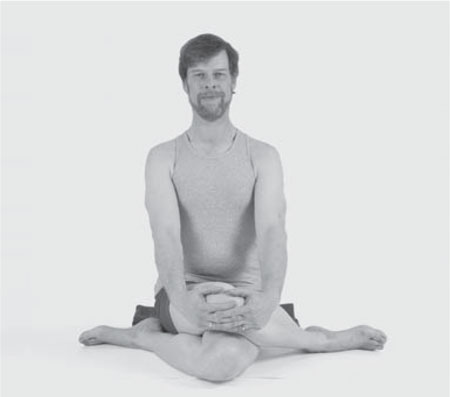
FIG. 3.25
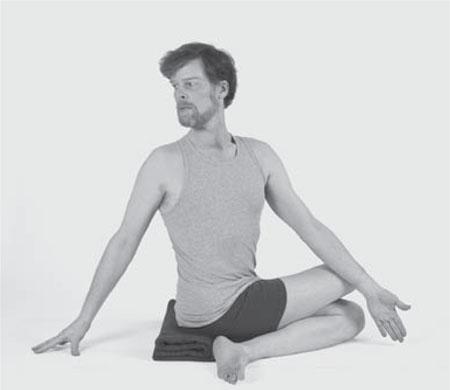
FIG. 3.26
Starting in the position described in step 1, lift your arms up with an inhalation and elongate your entire spine upward. As you exhale, turn to your right. Place your right hand on the floor (or on a block if you are sitting on a prop) behind your hips and place your left hand on the outside of your right thigh with your arm straight. With each inhalation lift your spine upward and, if your sacrum is comfortable, deepen the twist each time you exhale.
The key to happiness in any twist is to move mindfullyâand if you have a sacral issue, be sure your sacrum is stable and your spine is twisting gently from the bottom up. Slowly twist your lower back and waist first, then your ribs, then your upper chest and your shoulders. Let your head just follow along with the turning of your spine so you move from your core rather than your neck or head. When you've reached your final twist position, turn your head to look over your right shoulder and toward the floor, completing the twist through your entire spine (
fig. 3.26
). If you have a neck injury, though, keep your nose and chin in line with your breastbone.
Slowly unwind your spine and release the twist. You'll twist to your left when you change the cross of your legs. Right now, move on to the side-bending step described below.
Step 3: Bend to Your Side
In Seated Crossed-Legged Pose (step 1), place your left hand on the floor about a foot away from your left hip. Lift your right arm up and over your ear, leaning to the left as long as the right side of your trunk feels a comfortable stretch (
fig. 3.27
). For more stretch, you can place your left forearm on the floor. Breathe into the musculature along your right hip, waist, and ribs and let your side body release as you exhale. Hold the stretch for fifteen to twenty seconds, then press your left hand into the floor to help lift your torso back up to sitting position.
Side bending stretches the outer hip, the sacral band, and the lower back. After you come out of the pose, sit upright for a breath or two and bring your awareness into your right hip. Feel length and space along the sides and back of your hips and across your sacral band.
Step 4: Bend Forward
Start again in Seated Crossed-Legged Pose. Lift your arms up over your head with an inhalation, and as you exhale, bend forward from your hips, placing your hands on the floor in front of you. If you can't reach the floor, place your hands on a block. As you inhale, elongate the front of your trunk upward, and with your exhale start to move into a forward bend (
fig. 3.28
).
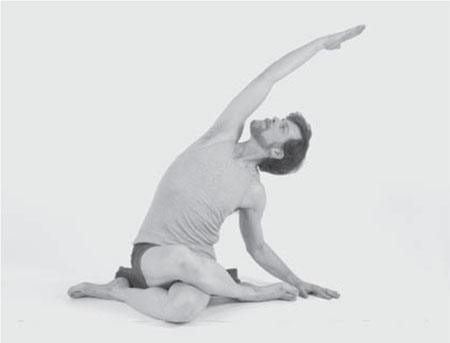
FIG. 3.27
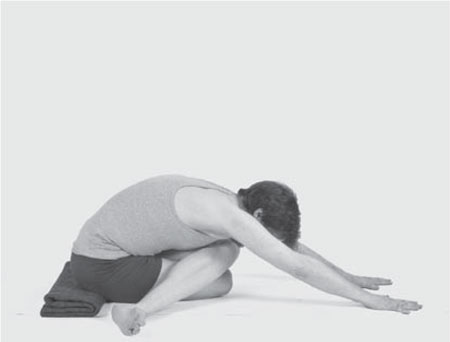
FIG. 3.28
It's important to feel that your spine is moving forward as you come into a forward-bending position, even though your sacral joints will naturally move slightly backward in counternutation. You can tell if you're on the right track by placing your hands on your back hip bones. As you bend forward, can you feel your back hip bones also moving forward? If so, you're bending correctly, from your hips rather than from your back or chest. From your initial bend, let your lower and middle back follow your hips and sacral bone into a gentle, even curve along your whole spine. If your hip bones and lower back collapse backward, though, place your hips on more height until you feel the difference.
Hold the pose for fifteen to twenty seconds. Bring lots of breath into your hips! Feel the back of your hips and your sacral band broadening and expanding, remembering what you've learned about the sacral bone's healthy counternutation movement. Slowly come up from the forward bend with an inhalation, and return to Seated Crossed-Legged Pose.
